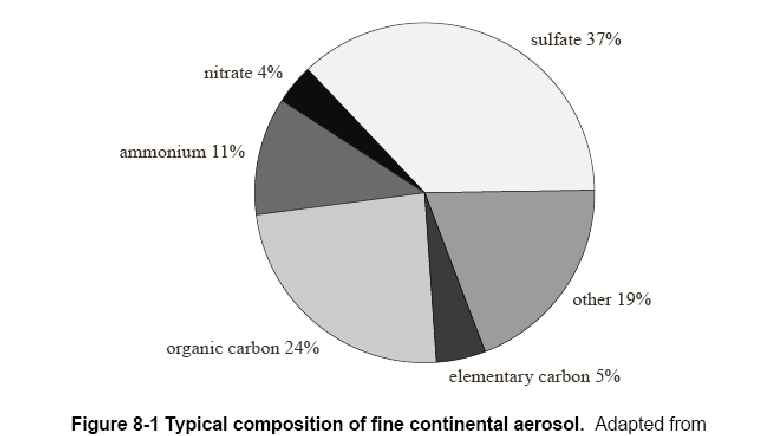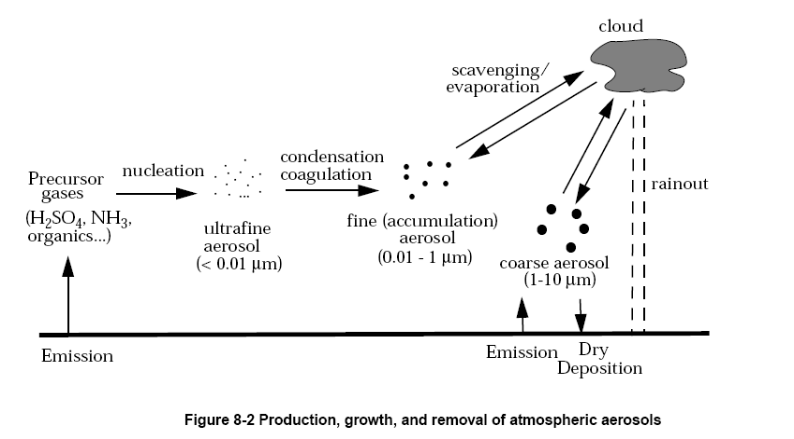
Влияние аэрозоля на баланс газовых примесей в атмосфере
Может быть, так называемое, прямое влияние аэрозоля на климат (прямой эффект). Оно заключается, во-первых, в обратном рассеянии в космическое пространство части солнечной радиации, увеличивая, тем самым, альбедо системы Земля – атмосфера и уменьшая температуры земной поверхности днем, т.е. в период освещения солнцем. Во-вторых, некоторые аэрозольные частицы поглощают солнечную радиацию и излучают инфракрасную радиацию, уменьшая эффект охлаждения из-за рассеяния назад. В-третьих, аэрозоли поглощают и переизлучают уходящую инфракрасную радиацию земной поверхности и нижней атмосферы, внося свой вклад в парниковый эффект.
Уменьшение температуры поверхности Земли вызывает уменьшение потоки энергии в пограничный слой атмосферы, уменьшая температуры ПСА. Ночью, наоборот аэрозоли увеличивают нисходящий поток ИК радиации, увеличивая, тем самым, температуру поверхности. В результате температура ПСА ночью увеличивается в результате воздействия аэрозоля.
Поглощающие свойства аэрозоля определяются его химическим составом, т.е. содержанием веществ, способных поглощать солнечную энергию. Если аэрозоль не содержит поглощающих радиацию веществ, то основной эффект – рассеяние ведет к охлаждению земной поверхности до 1.5 градусов. Если добавляется поглощающих веществ в количестве, уменьшающим альбедо однократного рассеяния с 1 до 0.83, то наблюдается нагрев земной поверхности.
Знак прямого эффекта влияния аэрозоля на климат меняется от района к району в зависимости от состава аэрозоля. В городских условиях антропогенные выбросы приводят к существованию поглощающих составляющих. В результате днем преобладает охлаждение, а ночью нагрев, с результирующим нагревом в среднем за сутки. Кроме того, вторичный аэрозоль, образующийся в результате газовых химических реакций, тоже получается разный в разных районах в зависимости от химического состава воздуха.
Кроме того, могут возникать непрямые эффекты влияния аэрозоля на климат. Аэрозольные частицы могут выступать в качестве ядер конденсации для облачных капель. Общая сконденсированная масса остается неизменной, т.к. она определяется термодинамикой, а количество облачных капель увеличивается. В результате средний размер облачных капель уменьшается. Суммарное сечение поглощения большого количества мелких частиц больше, чем суммарное сечение поглощения малого количества больших частиц с одинаковым общим объемом. Суммарное альбедо увеличивается. В результате происходит охлаждение воздуха у поверхности.
Второй непрямой эффект возникает в связи с тем, что уменьшение среднего размера аэрозольных частиц уменьшает гравитационное осаждение капель и количество осадков уменьшается, время жизни облаков увеличивается и альбедо системы тоже увеличивается, а температура уменьшается.
Аэрозоли также влияют на скорости фотодиссоциации атмосферных газов, тем самым, воздействуя на их концентрации, а через них на нагрев атмосферы и поверхности.
Sources and sinks of aerosols
Atmospheric aerosols originate from the condensation of gases and from the action of the wind on the Earth’s surface. Fine aerosol particles (less than 1 m in radius) originate almost exclusively from condensation of precursor gases. A typical chemical composition for fine aerosol in the lower troposphere is shown in Figure 1.

A key precursor gas is sulfuric acid (H2SO4), which is produced in the atmosphere by oxidation of sulfur dioxide (SO2) emitted from fossil fuel combustion, volcanoes, and other sources. H2SO4 has a low vapor pressure over H2SO4-H2O solutions and condenses under all atmospheric conditions to form aqueous sulfate particles. The composition of these sulfate particles can then be modified by condensation of other gases with low vapor pressure including NH3, HNO3, and organic compounds. Organic carbon represents a major fraction of the fine aerosol (Figure 1) and is contributed mainly by condensation of large hydrocarbons of biogenic and anthropogenic origin. Another important component of the fine aerosol is soot produced by condensation of gases during combustion. Soot as commonly defined includes both elemental carbon and black organic aggregates.
Mechanical action of the wind on the Earth’s surface emits sea salt, soil dust, and vegetation debris into the atmosphere. These aerosols consist mainly of coarse particles 1-10 m in radius. Particles finer than 1 m are difficult to generate mechanically because they have large area-to-volume ratios and hence their surface tension per unit aerosol volume is high. Particles coarser than 10 m are not easily lifted by the wind and have short atmospheric lifetimes because of their large sedimentation velocities.

Figure 2 illustrates the different processes involved in the production, growth, and eventual removal of atmospheric aerosol particles. Gas molecules are typically in the 10-4-10-3 m size range. Clustering of gas molecules (nucleation) produces ultrafine aerosols in the 10-3-10-2 m size range. These ultrafine aerosols grow rapidly to the 0.01-1 m fine aerosol size range by condensation of gases and by coagulation (collisions between particles during their random motions). Growth beyond 1 m is much slower because the particles are by then too large to grow rapidly by condensation of gases, and because the slower random motion of large particles reduces the coagulation rate. Aerosol particles originating from condensation of gases tend therefore to accumulate in the 0.01-1 m size range, often called the accumulation mode (as opposed to the ultrafine mode or the coarse mode). These particles are too small to sediment at a significant rate, and are removed from the atmosphere mainly by scavenging by cloud droplets and subsequent rainout (or direct scavenging by raindrops).
Coarse particles emitted by wind action are similarly removed by rainout. In addition they sediment at a significant rate, providing another pathway for removal. The sedimentation velocity of a 10 m radius particle at sea level is 1.2 cm s-1, as compared to 0.014 cm s-1 for a 0.1 m particle. The bulk of the atmospheric aerosol mass is present in the lower troposphere, reflecting the short residence time of aerosols against deposition (~1-2 weeks). Aerosol concentrations in the upper troposphere are typically 1-2 orders of magnitude lower than in the lower troposphere. The stratosphere contains however an ubiquitous H2SO4-H2O aerosol layer at 15-25 km altitude, which plays an important role for stratospheric ozone chemistry. This layer arises from the oxidation of carbonyl sulfide (COS), a biogenic gas with an atmospheric lifetime sufficiently long to penetrate the stratosphere. It is augmented episodically by oxidation of SO2 discharged in the stratosphere from large volcanic eruptions such as Mt. Pinatubo in 1991.
Although the stratospheric source of H2SO4 from COS oxidation is less than 0.1% of the tropospheric source of H2SO4, the lifetime of aerosols in the stratosphere is much longer than in the troposphere due to the lack of precipitation.
